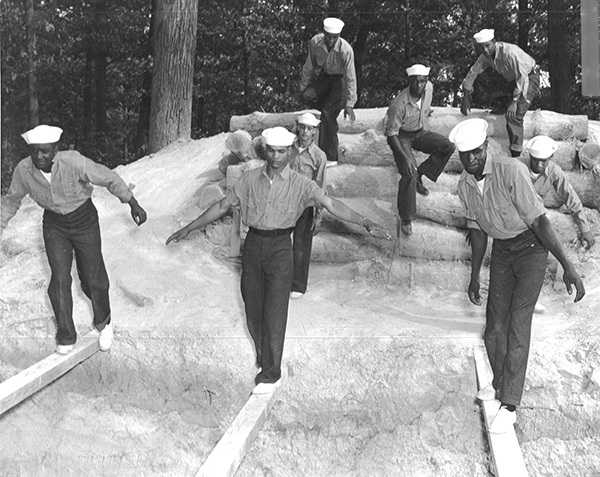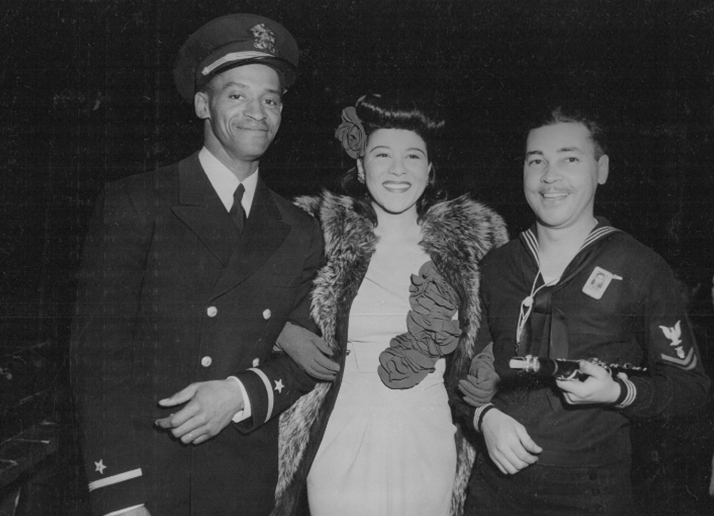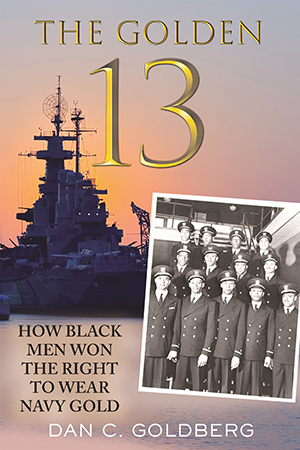Remembering ’The Golden 13’
Alumnus Dan Goldberg's new book restores first Black Naval officers to place in history

Dan Goldberg ’05 was searching the internet when he came across an obituary for Frank Sublett, one of the 13 Black men who integrated the U.S. Navy officers corps in 1944.
“I thought: ‘That’s an interesting story. I’ve never heard of these guys,’” he says. “How did the U.S. Navy go from not allowing Black men to so much as be trained as electricians or quartermasters after Pearl Harbor to deciding to train them as officers two years later in the middle of a war? It seemed like a fascinating story with the backdrop of the men’s heroism and characters.”
Goldberg said to himself: “There’s a book here. Someone should give it a full-length treatment.”
Nine years later, that someone is Goldberg — an award-winning healthcare reporter for Politico. The Golden Thirteen: How Black Men Won the Right to Wear Navy Gold, released in May by Beacon Press, combines oral histories, interviews with family members and seven years of research by Goldberg to bring a largely forgotten story back to life.
The men (Jesse Arbor, Phil Barnes, Sam Barnes, Dalton Baugh, George Cooper, Reginald Goodwin, James Hair, Charles Lear, Graham Martin, Dennis Nelson, John Reagan, Frank Sublett and William Sylvester White) not only endured racism after enlisting in the Navy, but were often disrespected when they became officers: Living quarters were subpar, scorn and epithets were common, white sailors refused to salute them and officers’ clubs emptied when they entered.
The Golden 13 could not be simply adequate. They had to quietly show superior leadership, temperament and ability. In the end, the men had the best class average in Naval history, but were not allowed into battle. It would take the Navy more than 30 years to celebrate the pioneers.
The journey to publication
In early 2011, Goldberg decided to contact family members of the Golden 13. By this time, all of the members were deceased and tracking down loved ones was not easy. Goldberg first located Hair’s son, James Jr., through a wedding announcement and had coffee with him in the spring of 2011.
“He agreed this was a good story and gave me the confidence to say ‘Let’s keep gathering string on this,’” Goldberg says. “Let’s keep researching and see how many wives and kids will talk to me. Let’s see how much I can find from archival research.”
Over the next several years, Goldberg talked with relatives from nine of the 13 families.
“I was ecstatic every time one of them picked up the phone!” Goldberg says. “They were happy someone was writing this book. I think some were confused why they were getting calls from a 30-year-old white kid after the story had been gone for so long. I’m pleased that they’ve all said nice things about the book. That makes me happy.”
The family members shared memories of their loved ones.
“It could be something small, like Dalton Baugh’s wife said that when he was in thought he had arms akimbo,” Goldberg says. “It’s a tiny detail that makes one sentence in the book. But it gives you a picture of Baugh. James Hair’s daughter told me that when her father laughed, he bent over at the waist. You get a picture of what they looked like in their 20s and 30s. It was like finding treasure.”
Goldberg also benefitted from an oral history of the Golden 13 conducted by Naval historian Paul Stillwell.
“Because he served in the Navy, I could email him questions,” Goldberg says. “He was always willing to answer. He read three drafts of the manuscript and hand-wrote notes in the margins of every page. For example, in the Navy, it’s a hat, not a cap. He could not have been more gracious. This book wouldn’t have happened without him.”
Doubt and rejection
Even while spending his weekends researching the 1940s, interviewing family members and getting advice from Stillwell, Goldberg had doubts “every day” about if he was the right person to tell the Golden 13 story.
“I was never in the military,” he says. “I’m not Black. I certainly wasn’t alive in the 1940s. I was conscious of what I wasn’t, so I tried as much as I could to not have my own voice in the book. The last thing the world needs is a 30-something-year-old white guy saying what Black people in the 1940s must’ve felt like. … I definitely had self-doubt and wondered: Is anyone going to read this?”
The book proposal was rejected by several publishers in 2017. Goldberg believes they did not want to take a chance on a first-time author and they were turned off by the fact that none of the 13 fought in battle.
“There’s no ‘scene’ when they are on the deck of a warship getting fired at,” he says. “I pitched the book with a newspaper mentality: It’s a good story and people will want to read it. But there is a business side to publishing and a lot of publishers are thinking: Who will Denzel Washington play in the movie? Where is the sex scene we can write in? They have to think about that side and I understand that, too.”
The racial perspective
Beacon Press, which is distributed by Penguin Random House, agreed to take on the book in 2017. Goldberg spent the next 18 months finalizing the writing. The story weaves from telling the backgrounds of the Golden 13 to how President Franklin D. Roosevelt, Secretary of the Navy Frank Knox and others debated whether to institute the officer training. Along the way, the book offers details about life in the Navy for a Black man in the 1940s.
Goldberg also highlights the importance of civil rights organizations and the Black newspapers of the era. Both groups were instrumental in exerting pressure on the government to see that equality was needed in the military.
“There are major civil rights figures who have been looked over,” Goldberg says. “I wanted to bring back Walter White and A. Phillip Randolph and talk about how people were at the White House challenging the president in the middle of the war. That’s important for what comes later. Civil rights didn’t start in the 1950s with Rosa Parks.”
The pervasiveness of racism in the 1940s is also illustrated throughout the book, such as when a group of Black soldiers were told at a Kansas lunch counter that they could not be served, while a few feet away a group of German prisoners of war sat eating. Goldberg admits he did not realize how apathetic some members of the Black community were at the beginning of World War II. To some, the war wasn’t worth the fight.
“In school, you are taught that Nazis are bad and the Japanese bombed us at Pearl Harbor,” he says. “Democracy vs. Hitler. Good vs. evil. It never occurred to me that people may have thought (sarcastically): ‘Oh, Germany thinks it’s a superior race’ or there was a belief that America was engaging in a hypocrisy. It certainly wasn’t taught to me.”
Lessons for today
While Goldberg’s book has restored the members of the Golden 13 to their rightful place in history, racial progress still needs to be made in the military. In the Navy, for example, there were 3,916 Black officers in 2019. More than 42,000 officers were white.
Goldberg sees a parallel between the struggles of the Golden 13 and those seeking civil rights in the 1940s with today’s battles against police violence and systemic racism.
“I hope that if you read this book, you can see that people were engaged in the same fight 80 years ago,” he says. “On the one hand, that is terribly depressing. It wasn’t until (recently) that the chief of naval operations said maybe the Navy should get rid of Confederate flags. On the other hand, there were protests and marches that led to the breakdown of the color barrier in the U.S. Navy officers’ ranks.
“I can say — through my research, not feelings — that in 1941–42, some people thought things would never change or get better. They would have been justified feeling that way. Then something did change. There is a lesson in persistence. These movements matter. You may not see it in the moment, but the arc does bend toward justice. I hope this story is an example of that.”


